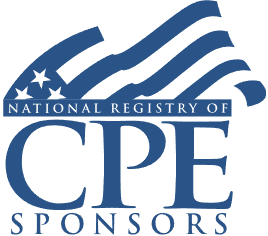IRC Section 645 Elections: Filing a Combined Qualified Revocable Trust and Estate Income Tax Return

Welcome! Strafford is now BARBRI! The expert courses you know from the trusted global leader in legal education.
Course Details
- smart_display Format
On-Demand
- signal_cellular_alt Difficulty Level
Intermediate
- work Practice Area
Tax Preparer
- event Date
Tuesday, February 28, 2023
- schedule Time
1:00 p.m. ET./10:00 a.m. PT
- timer Program Length
110 minutes
-
BARBRI is a NASBA CPE sponsor and this 110-minute webinar is accredited for 2.0 CPE credits.
-
BARBRI is an IRS-approved continuing education provider offering certified courses for Enrolled Agents (EA) and Tax Return Preparers (RTRP).
This course will explain how making the election under IRC Section 645 can significantly reduce the tax filing burden for practitioners and lower beneficiaries' tax obligations.
Faculty

Mr. Doyle provides clients with integrated wealth management advice on how to hold, manage and transfer their wealth in a tax efficient manner. He is the editor and co-author of Preparing Fiduciary Income Tax Returns, a contributing author of Preparing Estate Tax Returns and Understanding and Using Trusts and a contributing author of Drafting Irrevocable Trusts in Massachusetts. He is a lecturer in law in the Graduate Tax Program at Boston University School of Law.

Ms. Fukuto is a Tax Partner and specializes in the Estate and Trust Tax Services for Eide Bailly, LLP, a certified public accounting firm. With over 40 years of experience, she provides tax compliance, planning and consulting services for high net worth individuals, business succession and perpetuation planning for closely-held businesses and non-profit organizations. Ms. Fukuto's expertise includes estate and trust plan review and development, implementation and administration, tax compliance and strategic consulting services that allow her to work with complex estates and family wealth transfer issues. She obtained her Bachelor of Science in Accounting from the University of Southern California and her Masters degree in Taxation from Golden Gate University. Ms. Fukuto is a member of the American Institute of Certified Public Accountants and the California Society of Certified Public Accountants. She is also the Former Chair for the Orange County Estate Planning Council and Former Chair of the State Estate Planning Interest Group for the California Society of Certified Public Accountants.
Description
At death, a revocable living trust becomes irrevocable, creating the need for filing a trust return, Form 1041. Section 645 provides an opportunity to combine the filing of the trust return with the estate income tax return. When properly elected, the trust's income and expenses are reported along with the estate's, using the estate's year-end rather than the trust's required calendar year-end. Since estates often elect a fiscal year-end based on the decedent's date of death, this can significantly delay the filing requirement and paying the tax obligation.
Making the election allows many small estates to file a first and final Form 1041. Making the election, however, is irrevocable. While this election can provide significant flexibility, advisers must be aware of the potential tax consequences of failing to properly allocate income and distributions between the estate and its component trust. Also, the election terminates and, at the end of the termination period, beneficiaries could receive two K-1s, sometimes negating any tax benefit received from making the election.
Still, using estate guidelines for estimated tax payments and particularly charitable deductions can reap substantial tax savings for the beneficiaries of an estate.
Listen as our panel of trust and estate experts explains the caveats and considerations of making a Section 645 election.
Outline
- What is a qualified revocable trust?
- Section 645: making the election
- Due dates
- Filing the combined Form 1041
- Benefits
- Charitable contributions
- S corporation stock
- Estimated tax payments
- Certain passive losses
- Other benefits
- Caveats
- Termination
- Separate share rules
- Other caveats
- Illustrations
Benefits
The panel will discuss these and other important topics:
- Types of trusts that qualify as QRTs eligible to make a Section 645 election
- Applying the "separate share" rule to DNI calculations and allocations between the QRT and the estate after the election
- Post-mortem tax planning strategies present with a Section 645 election
- Mechanics of making the election with initial income tax filing
NASBA Details
Learning Objectives
After completing this course, you will be able to:
- Identify the types of trusts that qualify as qualified revocable trusts eligible to make an IRC 645 election
- Verify that the mechanics of making the IRC 645 election with the initial income tax filing are met
- Ascertain that all information required on the combined Form 1041 is provided to the IRS
- Apply the separate share rule to distributable net income calculations and allocations between the QRT and the estate after the election
- Determine the best tax planning strategies after the IRC 645 election terminates
- Establish what tax advantages are available to both the trust and estate when making the IRC 645 election
- Field of Study: Taxes
- Level of Knowledge: Intermediate
- Advance Preparation: None
- Teaching Method: Seminar/Lecture
- Delivery Method: Group-Internet (via computer)
- Attendance Monitoring Method: Attendance is monitored electronically via a participant's PIN and through a series of attendance verification prompts displayed throughout the program
- Prerequisite: Three years+ business or public firm experience at mid-level within the organization, preparing complex tax forms and schedules, supervising other preparers/accountants. Specific knowledge and understanding of revocable trust rules and structure, specific knowledge of estate and trust Form 1041 Income Tax Return and distributable net income calculations; familiarity with estate elections, separate share rule and distribution strategies..

Strafford Publications, Inc. is registered with the National Association of State Boards of Accountancy (NASBA) as a sponsor of continuing professional education on the National Registry of CPE Sponsors. State boards of Accountancy have final authority on the acceptance of individual courses for CPE Credits. Complaints regarding registered sponsons may be submitted to NASBA through its website: www.nasbaregistry.org.

Strafford is an IRS-approved continuing education provider offering certified courses for Enrolled Agents (EA) and Tax Return Preparers (RTRP).
Unlimited access to premium CLE courses:
- Annual access
- Available live and on-demand
- Best for attorneys and legal professionals
Unlimited access to premium CPE courses.:
- Annual access
- Available live and on-demand
- Best for CPAs and tax professionals
Unlimited access to premium CLE, CPE, Professional Skills and Practice-Ready courses.:
- Annual access
- Available live and on-demand
- Best for legal, accounting, and tax professionals
Unlimited access to Professional Skills and Practice-Ready courses:
- Annual access
- Available on-demand
- Best for new attorneys
Related Courses

Redemptions of Partnership Interests: Sections 736(b) vs. 736(a)
Friday, October 31, 2025
1:00 p.m. ET./10:00 a.m. PT

Multistate Tax Treatment of Multi-Tier Partnerships: Ingesting PTET in a Multi-Tier Entity
Friday, September 19, 2025
1:00 p.m. ET./10:00 a.m. PT

IRA Distributions and RMDs: Minimizing Taxes and Meeting SECURE 2.0 Requirements
Available On-Demand

Avoiding Gift and Estate Audit Triggers: Anticipating Audit Issues, IDRs, and Appeals
Tuesday, September 9, 2025
1:00 p.m. ET./10:00 a.m. PT
Recommended Resources
How CPE Can Bridge the Gap Between What You Know and What You Need to Know
- Career Advancement